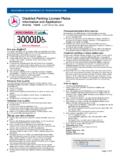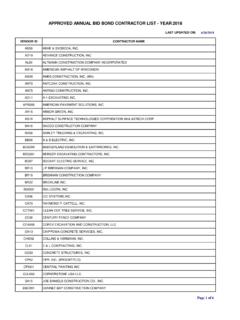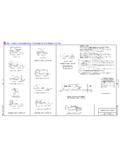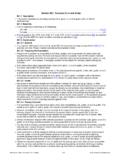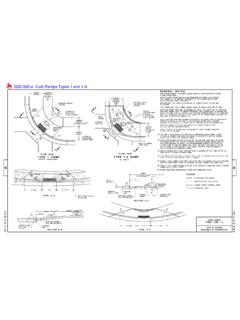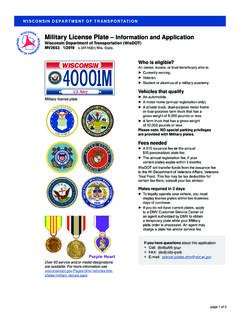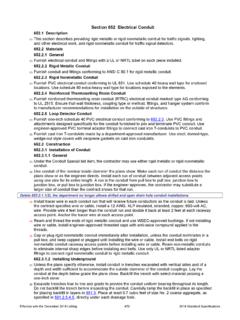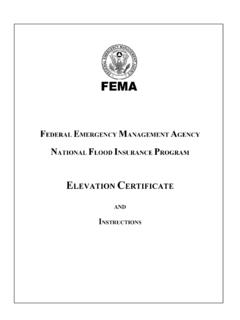Transcription of Chapter 8 Hydraulics - wisconsindot.gov
1 WisDOT Bridge Manual Chapter 8 Hydraulics July 2018 8-1 Table of Contents Introduction .. 4 Objectives of Highway Drainage .. 4 Basic Policy .. 4 Design Frequency .. 4 FHWA Directive .. 5 DNR-DOT Cooperative Agreement .. 5 DOT Facilities Development Manual .. 5 Hydraulic Site Report .. 5 Hydraulic Design Criteria for Temporary Structures .. 5 Erosion Control Parameters .. 6 Bridge Rehabilitation and Hydraulic Studies .. 6 Hydrologic Analysis .. 7 Regional Regression Equations .. 7 Watershed Comparison .. 7 Flood Insurance and Floodplain Studies .. 7 Natural Resources Conservation Service .. 8 Hydraulic Design of Bridges .. 9 Hydraulic Design Factors .. 9 Velocity .. 9 Roadway Overflow .. 9 Bridge Skew .. 9 Backwater and High-water Elevation .. 9 Freeboard .. 10 Scour .. 11 Design Procedures .. 11 Determine Design Discharge .. 11 Determine Hydraulic Stream Slope .. 11 Select Floodplain Cross-Section(s).
2 11 Assign Manning n Values to Section(s) .. 12 Select Hydraulic Model Methodology .. 12 Develop Hydraulic Model .. 13 Bridge Hydraulics .. 14 WisDOT Bridge Manual Chapter 8 Hydraulics July 2018 8-2 Roadway Overflow .. 14 Conduct Scour Evaluation .. 17 Live Bed and Clear Water Scour .. 18 Long-term Aggradation and Degradation .. 18 Contraction Scour .. 18 Local Scour .. 19 Design Considerations for Scour .. 24 Select Bridge Design Alternatives .. 24 Hydraulic Design of Box Culverts .. 26 Hydraulic Design Factors .. 26 Economics .. 26 Minimum Size .. 26 Allowable Velocities and Outlet Scour .. 26 Roadway Overflow .. 26 Culvert Skew .. 27 Backwater and Highwater Elevations .. 27 Debris Protection .. 27 Anti-Seepage Collar .. 27 Weep Holes .. 28 Design Procedure .. 29 Determine Design Discharge .. 29 Determine Hydraulic Stream Slope .. 29 Determine Tailwater Elevation .. 29 Design Methodology.
3 29 Develop Hydraulic Model .. 29 Roadway Overflow .. 36 Outlet Scour and Energy Dissipators .. 36 Drop Inlet.. 36 Drop Inlet Example Calculations .. 40 Drop Outlets .. 41 Drop Outlet Example Calculations .. 45 Hydraulic Jump Stilling Basins .. 48 Hydraulic Jump Stilling Basin Example Calculations .. 50 Riprap Stilling Basins .. 51 WisDOT Bridge Manual Chapter 8 Hydraulics July 2018 8-3 Select Culvert Design Alternatives .. 51 52 Appendix 8-A, Check List for Hydraulic/Site Report .. 54 Appendix 8-B, FHWA Hydraulic Engineering Publications .. 56 WisDOT Bridge Manual Chapter 8 Hydraulics July 2018 8-4 Introduction The methods of hydrologic and hydraulic analysis provided in this Chapter give the designer information necessary for an analysis of a roadway drainage crossing. Experience and sound engineering judgment are not to be ignored and may, at times, differ from results obtained using methods in this Chapter .
4 Very careful weighing of experience, judgment, and procedure must be made to arrive at a solution to the problem. Research in the field of drainage continues throughout the country and may subsequently alter the procedures found in this Chapter . Objectives of Highway Drainage The objective of highway drainage is to prevent the accumulation and retention of water on and/or around the highway by: Anticipating the amount and frequency of storm runoff. Determining natural points of concentration of discharge and other hydraulic controls. Removing detrimental amounts of surface and subsurface water. Providing the most efficient hydraulic design consistent with economy, the importance of the road, maintenance and legal obligations. Basic Policy In designing highway drainage, there are three major considerations; first, the safety of the traveling public, second, the design should be in accordance with sound engineering practices to economically protect and drain the highway, and third, in accordance with reasonable interpretation of the law, to protect private property from flooding, water soaking or other damage.
5 In general, the hydraulic adequacy of structures is determined by the methods as outlined in this manual and performance records of structures in the same or similar locations. Design Frequency Federal and State governments have placed increasing emphasis on environmental protection over the last several years. Consequently the administrative rules established by regulatory agencies have made past practice of designing structures to accommodate flood frequencies of 25 and 50 years obsolete and unworkable. Thus, the design discharge for all bridges and box culverts covered under this Chapter shall be the 100 year (Q100) frequency flood. In floodplain management this is also referred to as the Regional or Base flood. Design frequency is determined from requirements in Federal Highway Administration (FHWA) directives and the co-operative agreement between Wisconsin Department of Transportation (DOT) and Wisconsin Department of Natural Resources (DNR).
6 The following publications are suggested for guidance. WisDOT Bridge Manual Chapter 8 Hydraulics July 2018 8-5 FHWA Directive Title 23, Chapter 1, Sub Chapter G, Part 650, Subpart A of the FHWA Federal-Aid Policy Guide, Location and Hydraulic Design of Encroachments on Flood Plains , prescribes FHWA policy and procedures. Copies of this directive may be found on the FHWA website. DNR-DOT Cooperative Agreement The Wisconsin Department of Transportation and the Wisconsin Department of Natural Resources have signed a co-operative agreement to provide a reasonable and economical procedure for carrying out their respective duties in a manner that is in the total public interest. The provisions in this agreement establish the basic considerations for highway stream crossings. A copy of this agreement can be found in Figure 1, Procedure 20-30-1 of the Wisconsin DOT Facilities Development Manual (FDM).
7 DOT Facilities Development Manual Refer to Procedures - Chapter 13 - Drainage Practice, Chapter 20 - Environmental Laws, Policies and Regulations and Chapter 21 - Environmental Documents, Reports and Permits. Hydraulic Site Report The Stream Crossings Structure Survey Report shall be submitted for all bridge and box culvert projects. When submitting preliminary structure plans for a stream crossing, a hydraulic site report shall also be included. A check list of the various discussion items that need to be provided in the hydraulic site report is included as Appendix 8-A. Plan survey datum must conform to datum in use by local zoning authorities. In most cases elevations are referenced to the national geodetic vertical datum ( ngvd ) of 1929, or to the North American vertical datum of 1988 (NAVD 88). The Hydraulic Site Report discusses and documents the hydrologic, hydraulic, site conditions, and all other pertinent factors that influence the type, size, and location of the proposed structure.
8 Hydraulic Design Criteria for Temporary Structures The basic design criteria for temporary structures will to be the ability to pass a 5-year storm (Q5) with only feet of backwater over existing conditions. This criteria is only a general guideline and site specific factors and engineering judgment may indicate that this criteria is inappropriate. Separate hydraulic design criteria should be used for the design of temporary construction causeways. Factors that should be considered in the design of temporary structures and approach embankments are: Effects on surrounding property and buildings Velocities that would cause excessive scour Damage or inconvenience due to failure of temporary structure DNR concerns WisDOT Bridge Manual Chapter 8 Hydraulics July 2018 8-6 Temporary roadway profile Structure depths will be 36 for short spans and 48 or more for longer spans. If possible and practical, the temporary roadway profile should be designed and constructed in such a manner that infrequent flood events are not obstructed from overflowing the temporary profile and creating excessive backwaters upstream of the construction.
9 The temporary roadway profile should provide adequate clearance for the temporary structure. The roadway designer should indicate the need for a temporary structure on the Stream Crossing Structure Survey Report. Preliminary and Final plans should indicate the hydraulic parameters of the temporary structure. The required parameters are the 5-year flood discharge (Q5), the 5-year high-water elevation (HW5), and the flow area of the temporary structure required to pass the 5-year flood (Abr). Erosion Control Parameters In order to assist designers in determining the appropriate erosion control measures to be provided at Bridge construction site, preliminary and final plans should indicate the 2-year flood discharge (Q2), 2-year velocity, and the 2-year high-water elevation (HW2). Bridge Rehabilitation and Hydraulic Studies Generally no hydraulic study will be required in bridge rehabilitation projects that do not involve encroachment to the Base Floodplain.
10 This includes entire super structure replacement provided that the substructure and berm configuration remain unchanged and the low cord elevation is not significantly lowered. The designer should consider historical high-water elevations, Flood Insurance Studies and the potential of inundation when choosing the replacement superstructure type. The risk of damage to the structure as the result of Scour should also be considered. WisDOT Bridge Manual Chapter 8 Hydraulics July 2018 8-7 Hydrologic Analysis The first step in designing a hydraulic structure is to determine the design discharge for the waterway. The problem is particularly difficult for small watersheds, say under five square miles, because the smaller the area, the more sensitive it is to conditions which affect runoff and the less likely there are runoff records for the area. Acceptable methods of determining the design discharge for the 100 year flood shall be based on the guidelines contained in the State Administrative Code NR , Wisconsin s Floodplain Management Program1.
